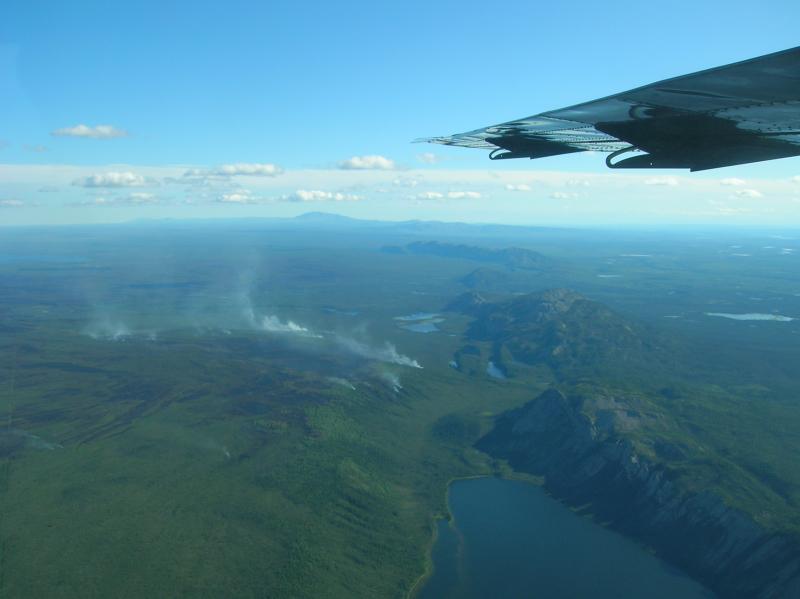How Boreal Wildfires Impact Birds
With wildfire smoke warnings in parts of Maine this past weekend, we are experiencing some of the unhealthy air that people in New York City and other urban areas dealt with a few weeks ago. Our discomfort is minor compared to those who live in the Boreal Forest region of Canada where the fires generating this smoke are occurring.
Many people across Canada have lost homes and cabins already this season from these fires. Others have had to evacuate to places far away, not knowing whether the flames will spare their communities from destruction. It became very real when a friend who had been visiting here in Maine last week at the Audubon camp at Hog Island texted from Manitoba that the wind had shifted and a fire was bearing down on her community. They were told to evacuate immediately to the town located three hours’ drive farther south.
This year is turning out to be perhaps the worst fire season in history in Canada. Over 400 fires have already been documented, encompassing a jaw-dropping area of more than 11 million acres, most within the Boreal Forest region. Sadly, the fire season has many months left to go.
Birds, too, are impacted by these massive fires and the smoke they generate. But there has been little research on exactly what happens to individual birds or their populations overall in these circumstances.
For those species already on territory or sitting on eggs, a large, hotly burning fire certainly destroys nests and eggs, and kill adults who don’t quickly flee the flames. Later-arriving migrants, like some of those that make their way north from South American wintering grounds, may arrive to find the familiar home territory on fire or burned up. Presumably they would move on to unfamiliar areas that had not been burned, places already crowded with others of their kind who would not welcome new neighbors.
Such dynamics happening over the millions of acres of forest that have already been burned by wildfire impacts millions of birds. It’s impossible, though, to know how many of each species are killed, how many nests and eggs are destroyed, how much habitat becomes unsuitable for species dependent on more mature forest.
And we haven’t even mentioned the ways that the smoke itself might affect birds, even far from the location of the fire. Canaries were taken down into coal mines by miners precisely because they were quicker to succumb from exposure to dangerous gases than humans, giving miners a chance to escape if they noticed the canary acting strangely. The plumes of smoke, filled with particulates, blown hundreds of miles from the fire locations are thought to cause damage to some birds’ lungs just as they do to humans with breathing problems. Some birds may become ill or even die depending on the length of exposure and how many pollutants and particulates are in the smoke. The number of birds that might have been sickened or killed by the smoke from these Canadian fires is, of course, unknown. We do know, however, it is tragic.
Birders will be on alert to see if they notice any changes in the numbers of Boreal Forest-nesting species as they pass through in fall migration or if some individuals head south early because of a failed breeding season up north as a result of the fires. Broader population-level changes will probably not be detectable until many survey efforts can be brought together for analyses and comparison several years into the future, although new eBird analyses techniques may offer some earlier insight.
Fires have always been part of the ecology of the Boreal Forest region. Fires make more habitat for early successional species and for specialist species like black-backed woodpeckers. But over time the fires are happening earlier, are larger, more intense and more frequent--the result of climate change. Quickly reducing carbon emissions from industrial activities as well as from cars and trucks is urgently needed for so many reasons, including to change the trajectory of wildfire activity in the Boreal Forest.
Jeffrey V. Wells, Ph.D., is a Fellow of the Cornell Lab of Ornithology and Vice President of Boreal Conservation for National Audubon. Dr. Wells is one of the nation's leading bird experts and conservation biologists. He is a coauthor of the seminal “Birds of Maine” book and author of the “Birder’s Conservation Handbook.” His grandfather, the late John Chase, was a columnist for the Boothbay Register for many years. Allison Childs Wells, formerly of the Cornell Lab of Ornithology, is a senior director at the Natural Resources Council of Maine, a nonprofit membership organization working statewide to protect the nature of Maine. Both are widely published natural history writers and are the authors of the popular books, “Maine’s Favorite Birds” (Tilbury House) and “Birds of Aruba, Bonaire, and Curaçao: A Site and Field Guide,” (Cornell University Press).






























.png)
.png)

